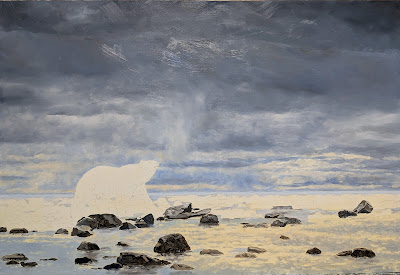Some artists wield a palette knife expertly when they apply paint to a canvas or board. I view this tool differently.
For me it is essential for mixing paint. I like one which is an elongated diamond with a sharp pointy end.
Secondly, I use my palette knife for mistakes. In this piece I had my whole sky carefully designed and drawn. Lights and darks would be blended just right to give a feeling of the type of stormy skies they have around Hudson Bay, Manitoba. I painted it. It didn't work.
I tried fixing it but all I ended up with was a mess. Time for the palette knife. I scraped off the majority of paint. You'd probably like to see what it looked like before I grabbed the palette knife. Well, I didn't take a photo of it - in too big a hurry to "erase" it. This is one great advantage of oil paint. While it is still wet one can remove it and not be distracted by its lack of success.
Time to regroup. What type of storms do I remember from my times there? How can I incorporate them into the overall plan? There are some aspects of my design I could use. After putting on some music I starting painting with a less cerebral approach to the sky. Below is the result. It'll be tweaked throughout the painting but for me the sky feels more real and organic.










